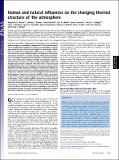| dc.contributor.author | Santer, Benjamin D. | |
| dc.contributor.author | Painter, Jeffrey F. | |
| dc.contributor.author | Bonfils, Celine | |
| dc.contributor.author | Mears, Carl A. | |
| dc.contributor.author | Solomon, Susan | |
| dc.contributor.author | Wigley, Tom M. L. | |
| dc.contributor.author | Gleckler, Peter J. | |
| dc.contributor.author | Schmidt, Gavin A. | |
| dc.contributor.author | Doutriaux, Charles | |
| dc.contributor.author | Gillett, Nathan P. | |
| dc.contributor.author | Taylor, Karl E. | |
| dc.contributor.author | Thorne, Peter W. | |
| dc.contributor.author | Wentz, Frank J. | |
| dc.date.accessioned | 2014-08-29T12:42:12Z | |
| dc.date.available | 2014-08-29T12:42:12Z | |
| dc.date.issued | 2013-10 | |
| dc.date.submitted | 2013-03 | |
| dc.identifier.issn | 0027-8424 | |
| dc.identifier.issn | 1091-6490 | |
| dc.identifier.uri | http://hdl.handle.net/1721.1/89102 | |
| dc.description.abstract | Since the late 1970s, satellite-based instruments have monitored global changes in atmospheric temperature. These measurements reveal multidecadal tropospheric warming and stratospheric cooling, punctuated by short-term volcanic signals of reverse sign. Similar long- and short-term temperature signals occur in model simulations driven by human-caused changes in atmospheric composition and natural variations in volcanic aerosols. Most previous comparisons of modeled and observed atmospheric temperature changes have used results from individual models and individual observational records. In contrast, we rely on a large multimodel archive and multiple observational datasets. We show that a human-caused latitude/altitude pattern of atmospheric temperature change can be identified with high statistical confidence in satellite data. Results are robust to current uncertainties in models and observations. Virtually all previous research in this area has attempted to discriminate an anthropogenic signal from internal variability. Here, we present evidence that a human-caused signal can also be identified relative to the larger “total” natural variability arising from sources internal to the climate system, solar irradiance changes, and volcanic forcing. Consistent signal identification occurs because both internal and total natural variability (as simulated by state-of-the-art models) cannot produce sustained global-scale tropospheric warming and stratospheric cooling. Our results provide clear evidence for a discernible human influence on the thermal structure of the atmosphere. | en_US |
| dc.language.iso | en_US | |
| dc.publisher | National Academy of Sciences (U.S.) | en_US |
| dc.relation.isversionof | http://dx.doi.org/10.1073/pnas.1305332110 | en_US |
| dc.rights | Article is made available in accordance with the publisher's policy and may be subject to US copyright law. Please refer to the publisher's site for terms of use. | en_US |
| dc.source | PNAS | en_US |
| dc.title | Human and natural influences on the changing thermal structure of the atmosphere | en_US |
| dc.type | Article | en_US |
| dc.identifier.citation | Santer, B. D., J. F. Painter, C. Bonfils, C. A. Mears, S. Solomon, T. M. L. Wigley, P. J. Gleckler, et al. “Human and Natural Influences on the Changing Thermal Structure of the Atmosphere.” Proceedings of the National Academy of Sciences 110, no. 43 (September 16, 2013): 17235–17240. | en_US |
| dc.contributor.department | Massachusetts Institute of Technology. Department of Earth, Atmospheric, and Planetary Sciences | en_US |
| dc.contributor.mitauthor | Solomon, Susan | en_US |
| dc.relation.journal | Proceedings of the National Academy of Sciences | en_US |
| dc.eprint.version | Final published version | en_US |
| dc.type.uri | http://purl.org/eprint/type/JournalArticle | en_US |
| eprint.status | http://purl.org/eprint/status/PeerReviewed | en_US |
| dspace.orderedauthors | Santer, B. D.; Painter, J. F.; Bonfils, C.; Mears, C. A.; Solomon, S.; Wigley, T. M. L.; Gleckler, P. J.; Schmidt, G. A.; Doutriaux, C.; Gillett, N. P.; Taylor, K. E.; Thorne, P. W.; Wentz, F. J. | en_US |
| dc.identifier.orcid | https://orcid.org/0000-0002-2020-7581 | |
| mit.license | PUBLISHER_POLICY | en_US |
| mit.metadata.status | Complete | |
